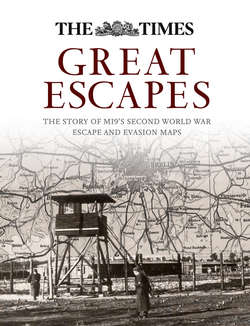Читать книгу Great Escapes: The story of MI9’s Second World War escape and evasion maps - Barbara Bond - Страница 18
EUROPE AIR 1:500,000 GSGS 3982 [FABRIC]
ОглавлениеDespite the evidence indicating that MI9 engaged initially with commercial companies to develop and progress the escape and evasion mapping programme, there was clearly contact with the operational map-makers at some stage since any map series carrying a GSGS series number is immediately identifiable as an operational series. This group of escape and evasion maps was produced by reducing the original operational Europe Air series from 1:250,000 scale to 1:500,000 scale. This reduction could only have been done from the original reproduction materials which would have been held by D.Survey since, apart from their scale and print medium, they are identical in all respects to the original lithographic paper maps.
Summary of Europe Air 1:500,000 GSGS 3982 [Fabric]
◊ 74 sheets identified
◊ 4 additional irregular sheets, based on Arnhem (‘Dutch Girl’); Sections 1, 2, 3, 4
◊ Coverage: Europe (see cover diagram opposite)
◊ Scale: 1:500,000; sheet N33/9 at 1:375,000; Arnhem maps at 1:420,000
◊ Print dates identified: June 1942 to August 1944
◊ Printed on: fabric, tissue, paper, mulberry leaf substitute (MLS), mulberry leaf (ML) tissue
◊ Printed in six colours
◊ Copies printed: 35,100 plus 8,221 Arnhem maps
For full details of the maps, see Appendix 3.
Cover diagram of the Europe Air 1:500,000 GSGS 3982 [Fabric].
As a result of the scale reduction, the escape and evasion maps were one quarter the size of the original operational lithographic maps printed on paper. These maps were variously referred to as ‘miniatures’ or ‘handkerchief’ maps (while no confirmation of this description has been found in the records, it carries the ring of authenticity because of the small size of the maps and their reduced scale). The sheets were printed in six colours and individual sheet coverage is two degrees of longitude (°E) and one degree of latitude (°N). All geographical values of the extent and coverage of individual sheets have been derived from an index of the original series acquired from the Defence Geographic Centre (DGC). This index has also been used as the basis of the cover diagram shown on page 61.
Turin, Europe Air 1:500,000 GSGS 3982 [Fabric], sheet L32/7.
Detail from this sheet, clearly showing the borders of Switzerland, France and Italy.
Escape and evasion versions of some seventy-four sheets were produced. Over 35,000 copies were printed between 10 July 1942, when production apparently commenced, and an unrecorded day in July/August 1944, when the decision was taken to cease production. One can therefore conjecture that MI9’s contact with D.Survey, either directly or using the Ministry of Supply as an intermediary, had started at least by mid-1942. Despite the significant number of copies produced, relatively few surviving sheets have been discovered. This may reflect the fact that many of the print runs were very small, 45 and 100 being common.
The sheets in this series were produced sometimes singly and sometimes in combination, although it has not proved possible to identify from the records the various combinations which were produced. They were produced on fabric or paper, the latter being variously described in the print record as ‘RL’, an acknowledged abbreviation for rag lithographic paper, ‘thin BANK paper’, ML (Mulberry Leaf) or MLS (Mulberry Leaf Substitute). One interesting group of a block of four of these sheets was produced under the codeword ‘Dutch Girl’. They are centred on Arnhem and are of non-standard geographical extent, location and scale, being 1 inch to 6.56 miles or approximately 1:420,000; as a result they are referred to in the record as Sections 1, 2, 3 and 4. The record shows that some 4,400 copies of these four sheets were produced in June 1942 and were described by Hutton in earlier correspondence with Waddington as ‘a very, very urgent requirement’. The purpose of producing these sheets at that stage is not clear, although it might have related to the combined operations which took place at that time and are known to have involved Section X of MI9 and the Special Operations Executive (SOE). In all probability, the subsequent printing of the same sheets, which took place in the period prior to August 1944, was in timely support of the Battle of Arnhem, otherwise referred to as Operation Market Garden, which took place in September 1944.
